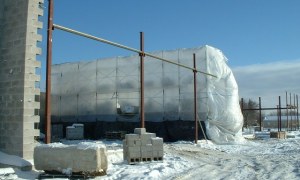🕑 Reading time: 1 minute
Load bearing masonry construction is one of the oldest and most widespread construction techniques in the world. Every wall element in a load bearing masonry structure carries the load to the foundation which is then transferred to the soil. Load bearing masonry construction is mainly used to construct smaller residential buildings.
Contents:
Features of Load Bearing Masonry Structure
Load bearing masonry construction technique involves the placing of the masonry unit as a layer one at a time. The masonry units are held together by means of mortar which imparts strength and stability to the whole unit.
The key feature of a load bearing structure is that every wall acts as a load carrying element. To meet this purpose, the walls are constructed strong with a thickness of 9 inches or more.
Read More: Thickness of Different Masonry Walls

The masonry walls transfer load from the roof to the foundation. The load path of a load-bearing masonry structure is:

The mortars used for the construction of these structures can be either:
- Cement Mortars
- Lime mortars
- Synthetic Adhesives
Types of Load Bearing Masonry Construction
The classification of load-bearing masonry construction is done on the basis of the type of masonry unit used. They are:
1. Stone, Brick or Block Masonry Construction
These are load bearing structures constructed by using stones, bricks or concrete blocks. This type of masonry can be used for both exterior and interior wall construction.
2. Cavity Masonry Construction
The cavity masonry structure involves two walls constructed with a hollow space or a cavity. The interior and the exterior walls reflects brick's beauty and texture. Cavity masonry construction demands lower maintenance.
3. Reinforced or Non-Reinforced Masonry Construction
Construction of reinforced masonry walls as load bearing elements helps to withstand heavy tension and compressive forces. A load-bearing masonry wall can also be constructed without steel reinforcement. This type is less used as it results in noticeable cracks and serviceability issues.
4. Single Material or Composite Masonry Construction
The load-bearing structure can be either built by a single material or as a composite structure. Composite load bearing masonry construction incorporates two or more units like stones, hollow bricks or bricks. This structure brings better appearance and attains economy.
Benefits of Load Bearing Masonry Construction
Load bearing masonry construction provides the following benefits:
- The final
load bearing masonry structure constructed is highly durable and solid. - This structure type possesses high fire resistance.
- The masonry units are available in different
colors and textures, which provides freedom of creativity to the user. - Advance preparations or fabrication is not required for this type of construction.
- L
oad bearing masonry structures are aesthetically attractive. - The tools and equipment used for masonry construction are simple and cheap.
Disadvantages of Load Bearing Masonry Construction
Below are the main disadvantages of load bearing structure that have limited its application :
- Load bearing masonry structure performs badly during the action of earthquakes. If looked through the history of past earthquake disasters, most of the structures collapsed are
load bearing masonry buildings. As the weight of the load bearing structure is high, it highly attracts earthquakes. - Load bearing masonry construction employs more
labor . As this involves stacking of masonry units one over the other, it demands more humanlabor . - Load bearing masonry construction is slow. As mentioned above, it is a human process which takes too much time to complete compared to other construction technique.
- Load bearing structures consume a large number of masonry units. Hence this construction is labour intensive. More the material required, more is the consumption of green resources for their production.
- Costs for the total masonry units used for the construction of these structures make it unviable.
- The weight of the load bearing masonry structure is high.
- The thermal insulation properties of these structures are very poor.
Read More: Cracks in Masonry Walls


